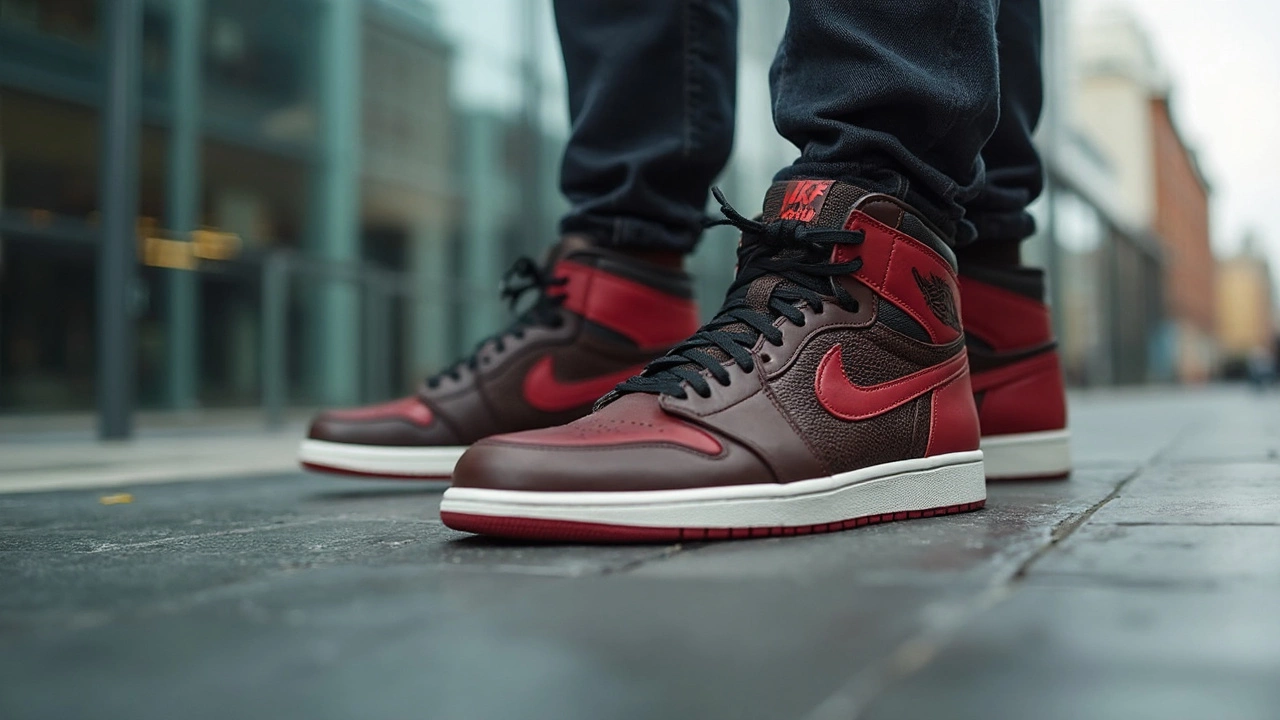Are Air Jordans Made of Leather? Unpacking the Materials

- Cleo Fairchild
- 9 March 2025
- 0 Comments
Air Jordans: they're more than just sneakers; they're an icon in the world of fashion and sportswear. But when it comes to what they're made of, things aren't as straightforward as you might think. Sure, you’ve probably heard that Air Jordans are made from leather, but what kind of leather are we talking about, and is it always real?
First off, let’s get to the leather part. Yes, leather is indeed a significant component used in various Air Jordan models. However, not every pair you see is made from genuine animal hide. Synthetic leathers often come into play, helping to keep certain models more affordable without sacrificing the iconic look and durability that fans love.
Now, if you're wondering how to spot the genuine article, it's easier than you might think. Real leather often has a distinct smell and texture – it’s more likely to show imperfections like scars or blemishes, which are actually a good sign. Fake leather, on the other hand, usually looks too perfect, almost plastic-like with a shiny finish. Knowing these differences can save you from a bad buying decision.
- Air Jordans: A Sneaker Icon
- What Materials are Used?
- The Role of Leather in Air Jordans
- Identifying Genuine Leather
- Caring for Your Leather Jordans
- Alternatives to Leather in Air Jordans
Air Jordans: A Sneaker Icon
When you think of sneaker culture, the Air Jordans undeniably stand at the top. Launched in 1985, these shoes carry a history that kicked off not just the start of a product line but a new era in fashion and sports marketing. Back in the day, the release of the first Air Jordan I was groundbreaking, going against the NBA rules with their striking red and black colors.
The legend behind the Air Jordans isn’t just about their edgy style. Michael Jordan’s on-court prowess catapulted the sneakers into fame. His games in them were performances that turned every pair into a piece of history. The Air Jordans became synonymous with high-flying dunks and game-winning shots, which Nike cleverly capitalized on to build an unshakeable brand identity.
Timeless Style and Innovation
What keeps Air Jordans so iconic is not just the nostalgia factor. Nike has mastered the art of blending functionality with fashion. From high-performance basketball technology to eye-catching designs, each iteration of the Air Jordans continues to build on a legacy where revolution never takes a backseat.
Even beyond sports, the Air Jordans have solidified their place in pop culture. They've been referenced in countless movies, songs, and other media, often symbolizing success and aspiration. With collaborations and limited editions, Jordan fans eagerly anticipate each new drop, often camping out or joining online queues to snag a pair.
The Cultural Impact
The influence of the Air Jordans stretches far beyond basketball courts. They’ve become a symbol of streetwear, influencing sneaker designs and trends across the globe. People from all walks of life identify with them as a part of their personal style. They transcend just being shoes; they're a statement.
| Year | Notable Model Release |
|---|---|
| 1985 | Air Jordan I |
| 1996 | Air Jordan XI |
| 2001 | Air Jordan XVII |
Knowing the significance of Air Jordans gives them depth beyond their leather and laces. Whether you're wearing them to stay in fashion or to hoop on the weekends, you’re walking in a piece of timeless innovation and culture.
What Materials are Used?
The materials used in making Air Jordans are as diverse as the designs themselves. These sneakers blend different materials to achieve the perfect mix of comfort, style, and durability that fans rave about.
One of the primary materials, as many might guess, is leather—or sometimes faux leather. Genuine leather adds a premium touch to the sneaker, offering both elegance and endurance. It’s particularly prevalent in classic models like the Air Jordan 1. For those who prioritize animal-friendly options or want something more affordable, synthetic alternatives mimic the look and feel of leather remarkably well.
Nubuck and Suede
Aside from standard leather, many Air Jordans feature nubuck and suede. These materials provide a softer finish and are often used in combination to create dynamic, textured looks. While they look and feel great, they do require special care to maintain their appearance.
Textiles and Mesh
Textiles and mesh are popular choices too, especially in models designed with athlete performance in mind. They offer breathability and flexibility, making these Jordans ideal for both casual daily wear and on-court action. The lighter weight provided by these materials helps players stay quick on their feet.
Rubber and Foam
Don’t forget about the soles! Rubber is a go-to for making durable outsoles, providing excellent grip and support. The midsole often features foam materials, which are designed for cushioning and shock absorption. Variants like Phylon or EVA foam are common, known for being lightweight and comfortable.
Occasionally, some models might even incorporate cutting-edge fabrics and tech like Flyknit—an innovative knitting technique that results in a lightweight and form-fitting material. This not only optimizes performance but reduces waste in the manufacturing process.
Understanding these materials helps you appreciate the craftsmanship and thought that goes into each pair. So the next time you're eyeing a pair of Air Jordans, you'll know exactly what goes into making them a top-notch choice for sneaker enthusiasts.
The Role of Leather in Air Jordans
Leather has always been a crucial ingredient in crafting the celebrated Air Jordans. This choice wasn't just about style; it was about creating a shoe that could perform on the basketball court and look great on the street. The use of high-quality leather gives Air Jordans their distinct appeal with a touch of luxury that sneaker enthusiasts crave.
One of the main reasons behind using leather is its durability. The basketball environment is tough, and players need shoes that won’t wear out easily. Leather provides the necessary robustness, allowing for prolonged use without compromising on the shoe's shape or comfort.
The Types of Leather
Not all leather is created equal. Various models of Air Jordans employ different kinds of leather.
- Full-grain leather: Typically used in some of the higher-end models. This leather maintains the natural surface with all its imperfections and is known for its durability and breathability.
- Top-grain leather: This is a more refined version where the surface has been sanded to remove imperfections. It’s smoother and has a more uniform look, commonly used where aesthetics are key.
- Synthetic leather: Though not genuine, it resembles real leather and keeps costs down. It's more in low-cost Air Jordans, making them accessible to a broader audience.
Benefits of Leather in Air Jordans
Besides durability, leather enhances comfort. It molds to the foot over time, providing a personalized fit. The breathability of natural leather also helps in keeping your feet cooler during intense basketball games or casual wear.
The look is another big draw. Leather tends to age well, developing a patina over time that can add to the shoe's character and uniqueness. This aesthetic value is part of what makes Air Jordans not just shoes but collectibles.
It's fascinating to see how sustainable practices are being adopted in the production of these leather components too. Companies are taking steps to source leather responsibly, aligning with growing consumer demands for eco-friendly products. This shift helps keep the legacy alive without compromising ethical standards.
Every pair of Air Jordans with leather tells its own story—a blend of sports heritage, modern design, and timeless style. Whether you're on the court or on the street, that iconic leather plays a part in your journey.

Identifying Genuine Leather
Wondering if those fresh Air Jordans you've got your eyes on are made of real leather? It's a common question, especially when many J's, like the Air Jordans, come with a hefty price tag. Real leather has its perks – it's durable, ages better, and feels as good as it looks.
How to Spot Real Leather
There are a few tricks to help you figure this out:
- Smell Test: Real leather has a distinct, earthy smell that fake or synthetic materials just can't replicate. If the shoe smells like a plastic factory, you're likely looking at synthetic leather.
- Texture & Imperfections: Check out the surface of the shoe. Genuine leather comes with its own set of unique imperfections like small marks or grain patterns. If it's too smooth or looks like it was made in a mold, it might not be the real deal.
- Flexibility: When you press into the leather, it should stretch a bit and then return to its original shape. Fake leather usually feels stiff and won’t mold to pressure.
The Benefits of Real Leather
Beyond aesthetics, real leather brings practical benefits to your sneaker game. It offers breathability, which means your feet are less likely to sweat buckets. Plus, leather is durable, so your kicking investment is more likely to last through whatever adventures you throw at it.
Keen Eye on Pricing
It's also worth noting the price. Genuine leather can bump up the price tag. If you see a pair of Air Jordans at a price that's too good to be true, that's a red flag. Of course, there are good deals out there, but exercise caution.
Data on Leather Consumption
If you're into stats, here's an interesting tidbit: globally, the leather shoe industry, including brands like Jordans, uses a significant portion of the world's leather output. Check this simple table for a peek into leather production:
| Year | Global Leather Production (Billion square feet) |
|---|---|
| 2022 | 24 |
| 2023 | 25 |
Armed with these tips, you should feel more confident when checking if your next pair of Air Jordans is made of genuine leather. Happy sneaker shopping!
Caring for Your Leather Jordans
Taking proper care of your leather Air Jordans is crucial if you want to keep that fresh-out-the-box look. And let's face it, nobody wants dull, worn-out sneakers when you’ve invested in something iconic.
Cleaning Routine
Walking around in your Jordans means they're going to get dirty. Here’s a simple cleaning routine:
- Start by removing the laces and use a soft brush to gently remove loose dirt or dust from the surface.
- Mix a solution of gentle soap and warm water. Dip a soft cloth in the mixture and wring it out.
- Clean the leather by wiping it with the cloth. Avoid soaking the leather – it doesn’t like getting too wet.
- Use a clean, dry cloth to remove any soap residue and moisture.
- Let them air dry completely away from direct sunlight or heat sources.
Conditioning the Leather
Conditioning is key. It keeps the leather soft and prevents cracking:
- Invest in a good leather conditioner specifically made for shoes. Apply it sparingly.
- A small dab on a soft cloth gently spread over the leather can make a world of difference.
- Do this every couple of months or whenever the leather looks dry.
Storage Tips
When you’re not showing off your kicks, correct storage is essential:
- Keep them in a cool, dry place. Avoid damp closets or places with too much heat.
- Store your Air Jordans in their original box or a shoe bag to protect them from dust and accidental scuffs.
By following these steps, your leather Jordans will not only look great but last a long time.
Alternatives to Leather in Air Jordans
Not everyone is into leather, and that's totally cool. The good news is that Air Jordans often come with options that don’t involve leather at all. With the rise of eco-friendly and vegan materials, Nike has been paying attention and offering alternatives that keep both style and Mother Earth in mind.
Mesh and Knit Fabrics
One popular alternative found in some Air Jordans is mesh or knit fabric. These materials are lightweight and super breathable, making them perfect for those hot summer days when you need some extra ventilation. Plus, they’re great for comfort without sacrificing the iconic look Jordans are known for.
Synthetic Leather
Synthetic leather, often made from polyvinyl chloride (PVC) or polyurethane (PU), offers a leather-like appearance without using any animal products. It’s durable and cost-effective, making it a frequent choice for Jordans. It's also easier to clean compared to traditional leather, which is a win if you're planning on showing off your kicks anywhere and everywhere.
Sustainability Moves
Recently, Nike has been stepping up its game with sustainable materials as part of their Move to Zero campaign, aiming to reduce carbon and waste. They've started using recycled materials, including recycled polyester and rubber, in some Air Jordan models. It’s all part of effort to make sneakers that not only look good but do good too.
- Sustainable materials like recycled polyester result in less environmental impact.
- Recycled rubber in outsoles is durable and reduces waste.
While traditionalists might still prefer the feel of leather, these alternatives offer practical, stylish, and, let’s be real, sometimes better everyday options. Whether it’s about staying cool, cutting costs, or giving our planet a little break, these materials keep Air Jordans as relevant as ever in the sneakerverse.


